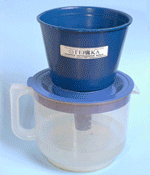Статьи по темам
Фотогалерея
Glimpses on the transfer of information in homeopathic dilutions
2009 г.
Rey L.
Aerial-CRT - Parc d'Innovation- BP 40443 F 67412 ILLKIRCH Cedex (France)
Chemin de Verdonnet 2 - CH 1010 LAUSANNE (Suisse)
A redundant issue in the assessment of homeopathy by classical academics, especially in the field of so-called «hard sciences», is the fact that, in high and ultra-high dilutions, there are no more traces of any original chemical. Hence, they claim that these different solutions are, indeed, all the same and no more than the mere solvent itself. Actually, this radical assumption proved to be wrong, at least in the light of more than two centuries of careful clinical observations which did show, to the evidence, that high dilutions were not only active in therapeutics but that they had also distinct personalities, both properties which could not be found in the solvent used for their preparation.
Water: a strange abnormal chemical
The whole story starts with water, a universal chemical, with a most simple formula, but, also, with abnormal properties. In the liquid state, the water molecules attract each other and erect all kinds of 3-D structures: dimers, oligomers and even most complex polymers because of their ability to build strong links between the tip of their two hydrogen arms and the oxygen nucleus of their neighbours, thanks to what has been called the «hydrogen bonds». However, these connections are in permanent motion and last, sometimes, for no more than a few tens of pico-seconds but they are permanently renewed. Basically, at the start, in the first dilutions,the chemical inclusions remain, of course, of prime importance and trigger the steric arrangement of water molecules but, when the solutes fade away along with the successive operations, the overwhelming issue becomes the structure itself and, at that time, it is some kind of a statistical structure, continuously disrupted but reconstituted along the same mode, which directs properties.
Thermoluminescence
It was to investigate these evanescent - but «statistically permanent» structures that we started our own research, making use of a rather novel investigation tool in the field: thermoluminescence (1-2). The basic idea was to try to avoid dealing directly with the ever-moving liquid solutions by turning them into a stable solid thanks to low-temperature freezing. The working hypothesis was that, should a given structural heterogeneity be present in the initial liquid state, it would be transferred into a corresponding set of «defects» within the resulting solid provided the freezing process is carried under well defined standard conditions. To investigate, in turn, this heterogeneous solid we selected to activate it by irradiation at liquid nitrogen temperature (77 K) inducing, there, the formation, within the solid matrix, of metastable radicals, electrons and holes positioned at different energy levels, referred to as traps. If thermal energy was progressively fed in, by controlled rewarming, these traps would empty, the one after the other, as a result of successive recombinations and would release their stored energy in the form of light, hence the name of low-temperature thermoluminescence. We expected , then, that the emission spectrum would represent a «finger-print» of the initial solution.
Our first observation and pleasant surprise was to discover that low-temperature thermoluminescence is a highly sensitive investigation method and that, for instance, we could discriminate very easily different highly diluted alumina colloids. Of course, our main interest lying with the analysis of high and ultra-high dilutions (3), we made use of this method to study, inter alia, potassium dichromate, sodium chloride and lithium chloride preparations made in D2O. For potassium dichromate, our experiments carried with Ilse Muchitsch and Michael Frass showed very clearly that their «finger prints» from C3 to C 24 were totally different from one another and from the one of the original heavy water (4).
We could state, then, that there is not one single doubt that high dilutions, even beyond the Avogadro number, are, indeed, totally different from the original pure solvent and that they are also specific to the precise chemicals dissolved at the initial state of their preparation. Thus, the claim made for long by the homeopaths can be considered as totally valid.
A major step in the Process: Succussion and the influence of the gas phase
At that point, and looking more closely to the process itself, we thought that, in the sequence of operations done to carry the dilutions, a major step was definitely the succussion (i.e. dynamization = potentiation). Many scientists, together with clinicians, have already reached that conclusion since non-dynamized dilutions always proved to be deprived of biological / therapeutical action. The violent mechanical stirring which is done during succussion is felt to develop, at each stroke, very high internal local pressures, probably in the thousands of bars range, and it is more than likely that, not only if affects the «structure» of the solution itself, but also its relationship with the internal wall of the container. At the same time it creates a very violent mix with the gas phase present in the vial and this results in the formation of a large amount of bubbles, some of them being in the sub-micronic range (3).
Nanobubles and «Bubstons»
Indeed, such behaviour leads us to believe that, at least, a significant part of the gas could remain in the bulk of the dilution as stable nano-bubbles. It is, indeed, known that in most liquids, even in stable still water, there is a certain «population» of permanent nano-bubbles driven by Brownian motion. It appears that these tiny gas inclusions are electrically charged as it has been proposed by A.F. Bunkin and al. in Russia (5). Indeed, to prevent that their internal pressure (over 100 bars) due to their huge surface tension pushes them to break up, these authors feel that the nano-bubbles are stabilized by a multi-layer of adsorbed ions at their surface, which, by mutual repulsion, create a negative pressure compensating their internal pressure. For that reason, Bunkin has called them «bubstons» for bubbles stabilized by ions. As an additional input, we consider that this population of nano-bubbles develops, within the liquid, a large «internal surface» which could play a role in the «behaviour» of the dilution.
It is also possible that these nano-bubbles interact with the inner wall of the container where they have been visualized by James Tyrrell and from there, «exchange» with those wandering throughout the liquid. From one dilution step to the other they might transfer a «remedy-specific- message» linked to both the bubstons and the active micro-cavities of the container wall.
At the end of the road, one thing is sure: coherent physical measurements have demonstrated that high dilutions are selective, complex fluids which carry much more information than could be expected and this, indeed, provides a strong, positive scientific background to homeopathy.
1–L. Rey , Thermoluminescence de la glace, C.R. Physique, 1, 107-110, (2000)
2– L.Rey , Thermoluminescence of deuterated amorphous and crystalline ices, Radiation Phys.Chem.,72, 587-594, (2005)
3 –L. Rey, Can low-temperature thermoluminescence cast light on the nature of ultra-high dilutions ?, Homeopathy, 96, 170-174, (2007)
4–L. Rey, Thermoluminescence of ultra-high dilutions of lithium chloride and sodium chloride, Physica A, 323, 67-74 ( 2003 )
5– A.F.Bunkin, N.F. Bunkin, Lobeyev,A.V., A.A. Nurmatov, Interior structure of degassed water as studied by the four-photon polarization spectroscopy method, Physics Letters A, 349-355, (1996)
- Войдите или зарегистрируйтесь, чтобы получить возможность отправлять комментарии





 Нанотехнологии в водоочистке: достижения отечественной науки на службе здоровья.
Нанотехнологии в водоочистке: достижения отечественной науки на службе здоровья.
 Фильтры для воды "Геракл" с графеновым сорбентом: полный каталог и прайс-лист.
Фильтры для воды "Геракл" с графеновым сорбентом: полный каталог и прайс-лист.



